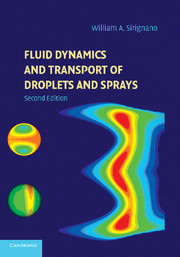Book contents
- Frontmatter
- Contents
- Preface
- Nomenclature
- 1 Introduction
- 2 Isolated Spherically Symmetric Droplet Vaporization and Heating
- 3 Convective Droplet Vaporization, Heating, and Acceleration
- 4 Multicomponent-Liquid Droplets
- 5 Droplet Behavior under Near-Critical, Transcritical, and Supercritical Conditions
- 6 Droplet Arrays and Groups
- 7 Spray Equations
- 8 Computational Issues
- 9 Spray Applications
- 10 Spray Interactions with Turbulence and Vortical Structures
- 11 Film Vaporization
- 12 Stability of Liquid Streams
- Appendix A The Field Equations
- Appendix B Conserved Scalars
- Appendix C Droplet-Model Summary
- Bibliography
- Index
5 - Droplet Behavior under Near-Critical, Transcritical, and Supercritical Conditions
Published online by Cambridge University Press: 05 June 2012
- Frontmatter
- Contents
- Preface
- Nomenclature
- 1 Introduction
- 2 Isolated Spherically Symmetric Droplet Vaporization and Heating
- 3 Convective Droplet Vaporization, Heating, and Acceleration
- 4 Multicomponent-Liquid Droplets
- 5 Droplet Behavior under Near-Critical, Transcritical, and Supercritical Conditions
- 6 Droplet Arrays and Groups
- 7 Spray Equations
- 8 Computational Issues
- 9 Spray Applications
- 10 Spray Interactions with Turbulence and Vortical Structures
- 11 Film Vaporization
- 12 Stability of Liquid Streams
- Appendix A The Field Equations
- Appendix B Conserved Scalars
- Appendix C Droplet-Model Summary
- Bibliography
- Index
Summary
High pressures and supercritical conditions in liquid-fueled diesel engines, jet engines, and liquid rocket engines present a challenge to the modelling and the fundamental understanding of the mechanisms controlling the mixing and combustion behavior of these devices. Accordingly, there has been a reemergence of investigations to provide a detailed description of the fundamental phenomena inherent in these conditions. Unresolved and controversial topics of interest include prediction of phase equilibria at high and supercritical pressures (Curtis and Farrell, 1988; Litchford and Jeng, 1990; Hsieh et al., 1991; Delplanque and Sirignano, 1993; Poplow, 1994; Yang and Lin, 1994; Delplanque and Potier, 1995; Haldenwang et al., 1996), including the choice of a proper equation of state, definition of the critical interface, importance of liquid diffusion, significance of transport-property singularities in the neighborhood of the critical mixing conditions, and influence of convection (including secondary atomization); d2-law behavior at supercritical conditions (Daou et al., 1995); droplet-lifetime predictions (Yang et al., 1992; Delplanque and Sirignano, 1993, 1994; Yang and Lin, 1994; Delplanque and Potier, 1995; Haldenwang et al., 1996); dense spray behavior (Delplanque and Sirignano, 1995; Jiang and Chiang, 1994a, 1994b, 1996); combustion-product condensation (Litchford and Jeng, 1990; Litchford et al., 1992; Delplanque and Sirignano, 1994; Daou et al., 1995); and flame structures at high and supercritical pressures (Daou et al., 1995). The actual combustion process is characterized by the supercritical combustion of relatively dense sprays in a highly convective environment.
- Type
- Chapter
- Information
- Fluid Dynamics and Transport of Droplets and Sprays , pp. 134 - 149Publisher: Cambridge University PressPrint publication year: 2010



